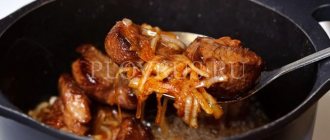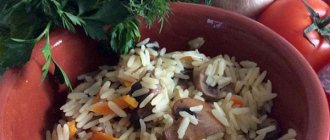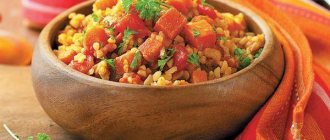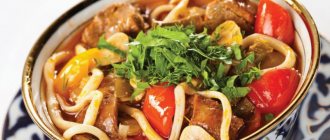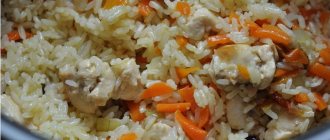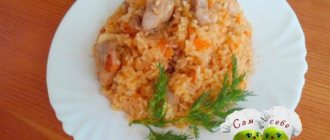Features of pilaf with barberry
Barberry berries have been used in the cooking of Eastern and Asian countries since ancient times: this spice combined gastronomic value with the ability to heal.
Therefore, everything that is prepared with this spice is not only tasty, but also very healthy. Barberry is not used as often in cooking in temperate latitudes as in the Caucasus and Asia. If they cook, it’s mainly drinks and jam, some desserts. For us, dried barberry berries are more of an exotic addition that you can safely do without. But if at least once you cook not just rice with meat, onions and carrots, but a luxurious dish with spicy notes and a subtle aroma of spices, it will be impossible to return to the past.
What barberry gives in pilaf: not only an appetizing sourness, but also substances that stimulate the secretion of gastric juice and enzymes (pectins and organic acids - tartaric, malic and citric). Pilaf is a very harmonious food that combines grains, vegetables and meat. Its peculiarity lies in the significant amount of fat that must saturate each grain of rice.
Such food is a big burden for the gastrointestinal tract, and therefore spices, herbs and fresh herbs must be added to it. The classic ready-made seasoning for pilaf is a mixture of cumin (a type of caraway), dried barberry, garlic and saffron (or turmeric). These fragrant spices affect fermentation no worse than advertised tablets that help with heaviness in the stomach.
Drying barberry for pilaf
A healthy and tasty seasoning can not only be purchased in the store, but also prepared at home by drying the barberries using an electric dryer or in the oven. Berries for drying are collected in late autumn, by which time they accumulate the most vitamins. The raw materials are sorted out: only ripe, unspoiled fruits without leaves or thorns are left. Then they are washed thoroughly, rubbing them with their hands without strong squeezing, and dried by laying them out on a paper towel.
The prepared berries are poured onto a baking sheet or into an electric dryer. In the second option, drying is carried out according to the instructions included with the electrical appliance, since the duration and technology of the process depends on its power.
Then turn off the oven and allow the berries to cool for 2 hours. The procedure is repeated several times until the barberry is dry both inside and outside. The finished seasoning is allowed to cool completely and transferred to storage containers.
Cooking pilaf with barberry
It’s not difficult to prepare delicious crumbly pilaf, but in order to end up with not rice porridge with additives, but a dish of the correct consistency, you need to use special dishes (a thick-walled cauldron with a lid that holds the temperature well) and varieties of rice that contain little starch. Pilaf with barberry according to a recipe considered classic, is prepared from lamb and devzira - Uzbek rice.
The recipe, designed for a 3-4 liter container, includes the following ingredients:
- lamb - 1 kg;
- devzira rice - 200 g;
- white onions - 4 pcs.;
- carrots (it’s better to take yellow ones) - 1 kg;
- garlic - 2-3 heads;
- vegetable oil - 300 ml;
- hot red pepper (dried) - 2 pcs.;
- ground cumin - 1 tbsp. l.;
- coriander seeds - 1 tsp;
- saffron - 1 tsp;
- barberry - 1 tbsp. l.;
- salt to taste.
The cooking process takes about 3 hours. Step-by-step instructions for it:
- The meat is cut into large pieces. After frying, their size will decrease.
- The rice is washed under running water until the liquid draining from the grain is no longer cloudy white.
- The top layer of skin is removed from the garlic, leaving the cloves together.
- All carrots and 3 onions are peeled. The root vegetable is cut into large strips, and the onion into half rings.
- Pour oil into a cauldron and heat it until it begins to boil. The remaining unpeeled onion is placed there and fried until black, then removed.
- Add the rest of the onion to the oil and fry it for about 10 minutes until its color turns golden.
- Then the meat is placed in the cauldron. The pieces are fried on all sides until golden brown.
- Add carrots and leave for 3 minutes without stirring. Then mix all the ingredients thoroughly and, continuing to stir, cook for another 8-10 minutes.
- The contents of the cauldron are poured with boiling water. The water level should be 1 cm above the level of the zirvak.
- Add pepper and simmer over low heat for 1 hour.
- Zira and coriander seeds are mixed, ground in a mortar or kneaded by hand. A mixture of spices along with saffron is added to the meat.
- Next, barberries are sent to the cauldron and zirvak is salted. Simmer it for another 10-15 minutes.
- The rice is washed one last time, placed in a sieve or fine colander and allowed to dry a little.
- Place the swollen cereal on the meat, spread it in an even layer, but do not mix it with the meat and vegetables.
- Turn the heat under the cauldron to maximum and pour boiling water over the rice. The water level should be 3 cm higher than the devzira layer.
After the liquid is completely absorbed into the cereal, press the garlic into the rice to the very top of each head. Then the contents of the cauldron are pierced to the bottom with a wooden stick, covered with a lid and left to simmer over low heat for about 30 minutes.
Zira (cumin or Roman cumin) is the seeds of an annual plant with a pleasant aroma and a spicy, slightly bitter taste. The recipe for pilaf with cumin, barberry, turmeric and poultry is suitable for people who like flavorful, but not too fatty dishes.
List of ingredients for 2 servings:
- turkey or chicken fillet - 0.5 kg;
- rice - 2 cups;
- onion and garlic - 1 pc.;
- red hot pepper - 1 pod;
- carrots - 4 pcs.;
- vegetable oil - 100 ml;
- cumin, turmeric and ground barberry - ½ tsp each;
- salt - 1 tsp.
Step by step recipe:
- Thoroughly washed rice is soaked in warm water for 2-3 hours.
- The peeled carrots are grated, the onion is cut into small cubes, and the poultry meat is cut into medium-sized pieces. Remove the top layer of skin from the garlic.
- Oil is poured into the pilaf container and heated over high heat until it boils.
- In calcined oil, first bring the onion to a soft golden color. Then add pieces of poultry to it, and after they are slightly browned, add carrots.
- The pilaf base is allowed to simmer, stirring it from time to time.
- After 10 minutes, place a head of garlic in the center of the zirvak, add cumin and enough hot water to lightly cover it.
- Add crushed barberries and bring the mixture to a boil. Then reduce the heat and wait until the liquid has almost completely evaporated. Now add salt, turmeric and pepper. The pod is left whole if you don’t want the dish to be too spicy.
- Drain the water from the soaked cereal and spread it in an even layer on the zirvak. Carefully add boiling water to the cauldron so that the water covers the rice by about 1 finger.
- Set the heat to maximum and wait until almost all the liquid has boiled away. You can check whether it remains in the cauldron with a wooden stick by piercing the layers of rice and meat to the bottom.
The pilaf is brought to full readiness over the lowest heat for 20-25 minutes after the cereal has absorbed all the water. Before serving, remove the pepper and garlic, and mix the rice with meat and vegetables.
Chickpeas are a type of pea that is often used in vegetarian cooking. It contains a lot of protein, so it makes food filling and healthy. For vegetarian pilaf with chickpeas and barberries you will need the following ingredients:
- rice of any low-cooking variety - 2 cups;
- chickpeas - 0.5 cups;
- medium-sized carrots - 3 pcs.;
- onions - 2-3 pcs. depending on size;
- garlic - 1 pc.;
- vegetable oil (preferably odorless) - 1 cup;
- soy meat - 2 handfuls;
- salt - 2.5 tsp;
- barberry - 1 tbsp. l.;
- cumin (cumin) - 1 tsp;
- red pepper (ground) - 1 tsp;
- asafoetida (can be replaced with a mixture of dried onions and garlic) - 1-2 pinches to taste.
Chickpeas are soaked in water 1-2 days before cooking. The liquid is periodically (once every 5-6 hours) drained and replaced with a new one, otherwise the peas will sour. 2 days after soaking, sprouts begin to appear on the chickpeas, which makes them more tender and pleasant to the taste. Well-washed rice grains are left to swell while the onions and carrots are dealt with. Vegetables are peeled and cut into feathers and strips, respectively.
Pour oil into a pilaf cauldron or cone-shaped pan, turn the heat to maximum and bring it to an overheated state (light smoke should come from the vegetable product). Do not reduce the heat, put carrots in oil and fry until light brown. Then add the onion, half a portion of salt, mix and fry for some more time until the onion acquires a golden hue.
Place the rice on top and press the garlic into it so that it is completely hidden by the grain. The rice layer should remain on top and should not be mixed with other ingredients. Pour the remaining salt onto the cereal and carefully pour boiled water from the kettle to a level 1.5-2 cm above the rice layer.
In Azerbaijani cuisine there is the concept of “zirish pilaf”. The word “zirish” means “barberry” in Azerbaijani, and the recipe for this dish includes fresh berries. You can also use frozen fruits to prepare it. Ingredients:
- 1 chicken weighing about 1 kg;
- 3 onions;
- 300 g basmati rice;
- gazmakh flatbread (can be replaced with lavash);
- 200-250 g melted butter;
- 150 g of ripe barberries;
- 150 g almonds;
- 30 g sugar;
- 2 pinches of saffron;
- black pepper and salt to taste.
During the cooking process, the pilaf is assembled from 3 parts: onion-meat, rice, cooked on a gasmakh, and the almond-barberry mixture gives the dish brightness and uniqueness.
You can prepare Gazmah yourself from 9 tbsp. l. flour, 4 tbsp. l. melted butter until liquid, 50 ml of water and a pinch of salt. Place all ingredients in a bowl and knead them into a medium-hard dough. The desired consistency is achieved by adding flour or water as needed.
Form a ball from the dough and knead it periodically for 1 hour. During this time, the butter will harden and the dough will become harder. It is rolled out into a thin cake (0.5 cm) and left to stand for 1.5-2 hours without covering. Powdered saffron is poured with a small amount of boiling water to obtain a thick, rich infusion of the spice.
The pilaf itself is prepared from rice that has been pre-washed and soaked in water for 1 hour. Boil the cereal in a large amount of salted water (approximate proportion - 1 liter per 1 glass) until half cooked, place in a colander or sieve and allow all the liquid to drain. The bottom of the cauldron is covered with a thick layer of oil. By this time, a crust should form on top of the deferred gazmach. The flatbread (or pita bread) is placed in a cauldron with the dried side on an oil layer, and the top is greased with the remaining oil.
The rice is laid out gradually on the gazma, periodically adding oil, of which there should be a lot, so that the grains are saturated with it, and the pilaf turns out crumbly and airy. The saffron infusion is poured into the central part of the rice layer, the remaining oil is placed on top and the cauldron is covered with a lid wrapped in a towel. The pilaf is simmered at minimum heat for at least 1 hour (even 2 is possible).
At this time they are working on a barberry-almond mixture. The barberry berries are sorted and washed, the skin is removed from the almonds and each piece is cut into 4 parts. To make it easier to remove the skin, the almonds are immersed in boiling water for 1 minute, and then doused with cold water. Heated with 1 tbsp. l. barberries sprinkled with sugar are fried in a frying pan in melted butter. After 1-2 minutes, add the almonds and continue to fry the mixture until the almonds have a pinkish tint.
Zirish pilaf is collected as follows. First, white rice taken from the edges of the cauldron is placed on the dish, then yellow rice from the central part and crispy gazmah cut into diamonds. Pieces of chicken are placed around the rice, and almonds and barberries are placed on top.
If the East is a delicate matter, then oriental cooking is doubly subtle. Here the final result depends on seemingly insignificant nuances and details. Eastern chefs master this art of jewelry to perfection, since half the success of a dish (including rice with meat) is the correct use of spices.
Recipe with cumin
Zira or cumin is considered the queen of spices in Asian countries. These are Indian cumin seeds with a special smell (you can barely hear nutty notes). In cooking, cumin powder and whole grains are used.
Additional Ingredients:
- beef or lamb – 0.5 kg;
- rice (better than Central Asian varieties) – 0.5 kg;
- onions – 3 heads;
- carrots – 0.5 kg;
- garlic – 2 small heads;
- hot pepper – 1 pod;
- barberry and cumin berries - 0.5 tbsp. spoons;
- coriander – 0.5 teaspoon;
- sunflower oil – 1 cup.
Preparation (step by step):
- Pour the rice washed several times with warm salted water.
- Prepare the food - cut the meat into small pieces, the onion into half rings, the carrots into strips.
- Heat the oil in a cauldron and fry the onion until it turns golden.
- Add the meat and fry until crispy. Add carrots and stir-fry for 10 minutes.
- Add seasonings, add salt to taste and simmer until the carrots become soft.
- Pour boiling water over the ingredients, covering the mixture by 1.5-2 cm. Add pepper, reduce the flame and simmer for about an hour.
- Place the rice on top and pour boiling water over it - carefully, through a slotted spoon, in a layer of at least 2 cm.
- When the moisture is absorbed, press the garlic into the rice, removing only the top layer of husk.
- Cook the pilaf until all the liquid has evaporated. Then use a spoon to collect the rice into a mound in the center of the cauldron, cover with a large plate and a lid on top.
- Remove the cauldron from the heat and leave the pilaf for half an hour until it reaches full “condition”. Stir the dish and serve.
Rules for using barberry in pilaf
This component of the classic set of spices for pilaf has a strongly pronounced sour taste with the presence of some sweetness. People who are not very experienced in the culinary arts often do not know when to add barberry and how much seasoning should be added so that its bouquet opens up and the taste of the dish is harmonious and not overly sour.
When to add
The basis of any pilaf is zirvak - meat fried with the addition of a large amount of carrots, onions and spices. All seasonings (garlic, pepper, saffron, cumin or turmeric) are added to the meat and vegetable mixture during stewing, with barberry being added last.
At this point, you can add a little water to the zirvak so that the berries are saturated with it, better reveal their smell and taste and mix with the aroma of browned meat pieces, caramelized carrots and sautéed onions.
Pilaf with barberry can be prepared using different technologies. Depending on what type of meat is used and what other ingredients are included in the recipe, the amount of seasoning also changes.
You need to add barberry in the proportion indicated in the recipe. An excessive amount of this spice can not only spoil the taste of pilaf, but also affect the health of the people who taste it.
How to cook pork pilaf so that the rice is crumbly
It seems that there is nothing difficult in preparing a delicious pilaf with meat, since the recipe is easy, and the necessary products are available to anyone! However, to make this dish truly impeccable, it is necessary not only to put a piece of your soul and heart into it, but also to scrupulously study the methods of its proper preparation. This wonderful pilaf recipe that I’m going to tell you about will definitely charm you and irrevocably win your love.
- pork pulp - 600-700 gr.;
- rice - 600 gr.;
- sunflower oil - 150 ml;
- onions - two pcs.;
- carrots - two pcs.;
- turmeric - one pinch;
- zira - one pinch;
- paprika - one pinch;
- pepper - one pinch;
- barberry - one pinch;
- salt - one pinch;
- dried tomatoes - one pinch.
Cooking steps:
1. Before you start the cooking process, you need to rinse the rice thoroughly and then leave it in cool water for a short time. Washed and dried meat must be cut into small cubes.
2. Place your cauldron on the stove and pour in sunflower oil. When calculating oil, it is necessary to take into account the fat content of pork. If the meat is fatty, then, accordingly, much less oil will be needed. Pour it into a cauldron and heat it well.
How can you tell if the oil is hot enough but not burning? You need to put a small clove of garlic or an onion ring in it. The oil is considered normally heated when a golden brown crust has formed on them.
3. Take out the onion and put the chopped pork in the cauldron.
4. While the meat is frying, let's prepare the vegetables.
5. Thoroughly wash and peel the carrots and onions.
6. Chop the onion into small pieces. Chop the carrots into neat strips or grate them.
7. You can add chopped vegetables to the slightly browned meat.
8. First of all, add the onion and fry it until a nice golden color.
9. Then add the carrots and fry them for a little more time with the meat.
10. After 10 minutes, add water. Meat and vegetables should be completely covered with liquid. Add spices, salt and pepper. Mix thoroughly. This preparation (zirak) for our pilaf should be left on the stove for about 20 minutes. This is necessary to ensure that the pork becomes tender and soft.
When and how much to add barberry to pilaf
It is important to know when to add barberry to pilaf. The extent to which it imparts its taste and aroma to the dish depends on this. In the classic version, it is customary to add all the spices to the zirvak when it is almost ready. Zirvak is a mixture of fried meat with onions and carrots, a base on which rice is placed. When to add barberry: last, often adding a little water to the frying with vegetables first - so that the spice “straightens out” already at this stage.
How many barberry berries you can take depends on the meat. For lamb you will need a tablespoon per 1 kg of pilaf (zirvak and rice in a 1:1 ratio). Beef pilaf with the same quantity and ratio of parts is seasoned with a teaspoon of barberry.
Other sour berries that you can find in the kitchen. It could be cranberries, prunes, cherry plums, etc. Although many believe that it is better not to replace this spice with anything.
Pilaf with chicken and barberry
In order to prepare a lighter version - pilaf with chicken - we will need 700 g of rice and chicken meat (it is better to cut it from the thighs), and in addition:
- Onions (2 pcs.).
- Carrots (3 pcs.).
- A glass of refined vegetable oil.
- Zira, turmeric and barberry (a teaspoon each).
- Ground salt and pepper to taste.
Cut the peeled onions and carrots into half rings and semicircles, and cut the meat into pieces. Heat the oil in a cast iron pan, throw in the meat, then the onions, then the carrots. As soon as the onions turn white, it’s time to add spices, salt and pepper. The zirvak is simmered for 20 minutes, after which we pour the rice on top and fill it with water to cover the finger.
Recipe with turmeric
Of the many varieties of the plant, curcuma longa is most often used in cooking. When added to dishes, the spice gives them a beautiful yellowish color.
Additional Ingredients:
- chicken fillet – 750 g;
- Arborio or Basmati rice – 700 g;
- carrots – 3 medium-sized pieces;
- onions – 2 large heads;
- vegetable oil – 250 g;
- turmeric – heaped teaspoon;
- barberry – 1 teaspoon;
- ground pepper (red and black) – 0.5 teaspoon each.
Step-by-step preparation:
- Prepare the ingredients as in the previous recipe. Fry the chopped fillet, onions and carrots in oil, stirring occasionally.
- Add salt to taste, turmeric, barberry and pepper to the cauldron, simmer the zirvak for 8-10 minutes.
- Lay out the rice, pour boiling lightly salted water 2.5 cm above the rice layer. Once the mixture boils, reduce the heat to medium.
- Cook until the water has evaporated, then simmer the pilaf over low heat for 15-20 minutes.
- Mix the ingredients and treat your loved ones to a delicious oriental dish.
